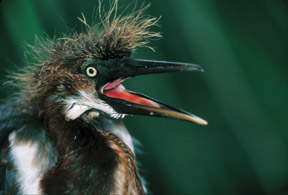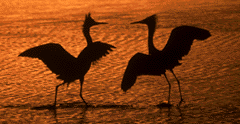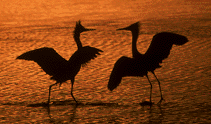Rookeries by necessity are cluttered places with branches
and whitewash everywhere. There is often filtered
sunlight. Lastly, there are so many birds that care needs
be taken to keep their out-of-focus white blobs out or
your backgrounds If you wish to use direct frontal natural
(sun) light, the rookery is strictly and afternoon
spot, especially this year as very few birds nested on the
left (west) side of the boardwalk.

(Tricolored Heron chick. Canon 500mm f/4 IS lens with
two 25mm extension tubes and one 12mm extension tube.
Canon EOS 1v body. Flash as main light at zero.)Canon
EOS 1v body)
Here are my tips for making good images at SAAF:
1-Never photograph a subject in filtered light.
2-Use your longest telephoto (often with tele-extenders)
so that your narrow angle of view reduces background
clutter.
3-Use extension tubes with your big lenses so that you
can work tight, and I mean tight!
4-In the morning, photograph nests that are totally
shaded. Use flash as main light to illuminate your
subjects (that--on sunny days--are actually somewhat
backlit even though they are seemingly in total shade).
5-Bring a short lens or two to photograph groups in the
nest. I always bring my 28-135mm and 100-400mm zooms
and use them with either an A2 or an Elan 7E so that I
may use the pop-up flash on these relatively inexpensive
bodies.
6-Bring a flight lens for the late-afternoon fly-in.
Like most rookeries, St. Augustine is a great place to
make hundreds of really bad images in a short time! But
that also makes it a great place to learn. Do note that
there are still four openings on the July 6-8, 2001
BIRDS AS ART/INSTRUCTIONAL PHOTO TOUR
at SAAF. See the web site for details. When I visited
recently there were lots of birds still on eggs and
building nests, so early July (though hotter than Hades)
should provide lots of great opportunities for both
learning and chick photography.


